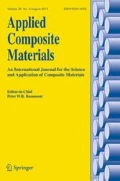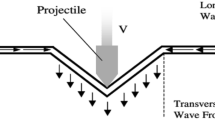Abstract
Three-dimensional braiding composite material has the advantages of high strength, high modulus, high temperature resistance, non-layered structure and easy design. Traditional high-performance metal materials will be replaced by 3D braiding composite material, so it has been highly valued and applied in many fields such as aerospace, weaponry and equipment. At present, there are many researches on 3D braiding technology, such as 3D rotary braiding machine and Cartesian 3D braiding machine in terms of braiding equipment. The research on the structure of preforms and the performance of composite materials are also more in-depth. The development of 3D braiding technology from the aspects of 3D fabric, braiding technology, equipment are summarized in this article. The development of 3D braiding technology requires high-speed automation and commercialization, this will be a challenge for 3D braiding technology in the future.







Similar content being viewed by others
Data Availability Statements
This paper introduces the development of three-dimensional braiding technology. There is no experimental data. The summary data involved in the article are all derived from the cited references. Data sharing not applicable to this article as no datasets were generated or analysed during the current study.
References
Gao, C., Wan, Y., Yan, T., et al.: Three-dimensional braided fabrics-reinforced composites for load-bearing orthopedic applications Part I: mechanical performance. Int. J. Mater. Res. 102, 309–316 (2011). https://doi.org/10.3139/146.110477
Li, J., Jiao, Y., Sun, Y., et al.: Experimental investigation of cut-edge effect on mechanical properties of three-dimensional braided composites. Mater. Des. 28, 2417–2424 (2007). https://doi.org/10.1016/j.matdes.2006.09.020
Hu, C.X., Li, H.J., Zhang, S.Y., et al.: Numerical simulation on thermal expansion coefficient of 3D braided C/C composites. Rare. Met. 33, 99–106 (2014). https://doi.org/10.1007/s12598-013-0083-4
Zhang, D., Sun, Y., Wang, X., Chen, L.: Meso-scale finite element analyses of three-dimensional five-directional braided composites subjected to uniaxial and biaxial loading. J. Reinf. Plast. Compos. 34(24), 1989–2005 (2015). https://doi.org/10.1177/0731684415596629
Behera, B.K., Dash, B.P.: An experimental investigation into the mechanical behaviour of 3D woven fabrics for structural composites. Fibers. Polym. 15, 1950–1955 (2014). https://doi.org/10.1007/s12221-014-1950-9
Sun, J., Zhou, G., Zhou, C.: Microstructure and mechanical properties of 3D surface-core 4-directional braided composites. J. Mater. Sci. 50, 7398–7412 (2015). https://doi.org/10.1007/s10853-015-9297-1
Lu, Z., Xia, B., Yang, Z.: Investigation on the tensile properties of three-dimensional full five-directional braided composites. Comput. Mater. Sci. 77, 445–455 (2013). https://doi.org/10.1016/j.commatsci.2013.04.010
Fang, G., Liang, J., Wang, B., et al.: Effect of Interface Properties on Mechanical Behavior of 3D Four-Directional Braided Composites with Large Braid Angle Subjected to Uniaxial Tension. Appl. Compos. Mater. 18, 449–465 (2011). https://doi.org/10.1007/s10443-010-9175-6
Kyosev, Y.: Numerical Modelling of 3D Braiding Machine with Variable Paths of the Carriers. Appl. Compos. Mater. 25, 773–783 (2018). https://doi.org/10.1007/s10443-018-9714-0
Dash, A.K., Behera, B.K.: Weave Design Aspects of 3D Textile Preforms Towards Mecha-nical Properties of Their Composites. Fibers. Polym. 20, 2146–2155 (2019). https://doi.org/10.1007/s12221-019-8841-z
Kashif, M., Hamdani, S.T.A., Nawab, Y., Asghar, M.A., Umair, M., Shaker, K.: Optimization of 3D woven preform for improved mechanical performance. J. Ind. Text. 48(7), 1206–1227 (2019). https://doi.org/10.1177/1528083718760802
Dong, J.W., Feng, M.L.: Asymptotic expansion homogenization for simulating progressive damage of 3D braided composites. Compos. Struct. 92(4), 873–882(2010). https://doi.org/10.1016/j.compstruct.2009.09.026
Zhang, C., Mao, C., Zhou, Y.: Meso-Scale Damage Simulation of 3D Braided Composites under Quasi-Static Axial Tension. Appl. Compos. Mater. 24, 1179–1199 (2017). https://doi.org/10.1007/s10443-016-9579-z
Zhou, H., Hu, D., Zhang, W., Gu, B., Sun, B.: The transverse impact responses of 3-D braided composite I-beam. Composites Part A: Appl. Sci. Manuf. 94, 158–169 (2017). https://doi.org/10.1016/j.compositesa.2016.11.033
Yan, S., Guo, L.Y., Zhao, J.Y., et al.: Effect of Braiding Angle on the Impact and Post-Impact Behavior of 3D Braided Composites. Strength. Mater. 49, 198–205 (2017). https://doi.org/10.1007/s11223-017-9858-4
Yan, J., Liu, K., Zhou, H. et al.: The bending fatigue comparison between 3D braided rectangular composites and T-beam composites. Fibers. Polym. 16, 634–639(2015). https://doi.org/10.1007/s12221-015-0634-4
Archer, E., Buchanan, S., McIlhagger, A., Quinn, J.: The effect of 3D weaving and consolidation on carbon fiber tows, fabrics, and composites. J. Reinf. Plast. Compos. 29(20), 3162–3170 (2010). https://doi.org/10.1177/0731684410371405
Chen, X.: Advances in 3D Textiles. Woodhead Publishing, Manchester (2015)
Bilisik, K.: Three-dimensional braiding for composites: a review. Text. Res. J. 83, 1414–1436 (2013). https://doi.org/10.1177/0040517512450766
Zhihong, S., Zhiyao, L., Shenhua, Z., Xiang, L.: Research on control algorithm for weaving non-equal diameter tubular fabric with constant weft density, 2013 IEEE 8th Conference on Industrial Electronics and Applications (ICIEA), p1589 (2013). https://doi.org/10.1109/ICIEA.2013.6566622
Hu, L., Tao, G., Liu, Z., et al.: Investigation on the Yarn Squeezing Effect of Three Dime-nsional Full Five Directional Braided Composites. Appl. Compos. Mater. 26, 371–387 (2019). https://doi.org/10.1007/s10443-018-9697-x
Florentine, R.A.: Apparatus for Weaving a Three Dimensional Article. US Patent No.4312261, January 26 (1982)
Pandey, R., Hahn, H. T.: Designing with 4-step braided fabric composites. Compos. Sci. Technol. 56(6), P623–634 (1996). https://doi.org/10.1016/0266-3538(96)00042-5
Li, D.S., Lu, Z.X., Chen, L., Li, J.L: Microstructure and mechanical properties of three-dimensional five-directional braided composites. Int. J. Solids. Struct. 46, P3422–3432(2009). https://doi.org/10.1016/j.ijsolstr.2009.05.013
Bilisik, K.: Multiaxis 3D weaving: Comparison of developed two weaving methods (tube-rapier weaving versus tube-carrier weaving) and effects of bias yarn path to the preform properties. Fibers. Polym. 11, 104–114 (2010). https://doi.org/10.1007/s12221-010-0104-y
Bilisik, K.: Multiaxis three-dimensional weaving for composites: A review. Text. Res. J. 82(7), p725-743 (2012). https://doi.org/10.1177/0040517511435013
Labanieh, A.R., Legrand, X., Koncar, V., Soulat, D.: Development in the multiaxis 3D weaving technology. Text. Res. J. 86(17), p1869-1884 (2016). https://doi.org/10.1177/0040517515612365
Bilisik, K., Mohamed, M.H.: Multiaxis Three-Dimensional Flat Woven Preforms - Tube Carrier Weaving. Text. Res. J. 80(8), p696-711 (2010). https://doi.org/10.1177/0040517509340602
Bogdanovich A.E.: An overview of three-dimensional braiding technologies Advances in braiding technology: Specialized techniques and applications (Woodhead publishing in textiles Number 177) ed Y Kyosev (Woodhead Publishing) 3–78 (2016)
Kyosev, Y.: Numerical Modelling of 3D Braiding Machine with Variable Paths of the Carriers. Appl. Compos. Mater. 25, p773-783 (2018). https://doi.org/10.1007/s10443-018-9714-0
Guowei, S.: Track design and realization of braiding for three-dimensional variably shaped cross-section preforms. J. Eng. Fibers. Fabr. 16, 1–11(2021). https://doi.org/10.1177/15589250211002510
Chengjie, D., Zhuo, M., Yujing, Z., Yize, S.: Modeling and analysis of the carrier arrangement in square rotary braiding. Text. Res. J. 89(19–20), p4208-4219 (2019). https://doi.org/10.1177/0040517519828998
Zhuo, M., Yujing, Z., Xintong, H., Yujie, C., Yize, S.: Modeling and analysis of the carrier arrangement in three-dimensional circular braiding. Text. Res. J. 88(1), 49–58 (2018). https://doi.org/10.1177/0040517516677227
Yu, Q., Sun, Z., Qiu, Y., et al.: Study on the braiding of preform with special-shaped sections based on the two-dimensional braiding process. Text. Res. J. 89(2), p172-181 (2019). https://doi.org/10.1177/0040517517741159
Lengersdorf, M., Gries, T.: Three-dimensional (3D)-maypole braiding Advances in braiding technology: Specialized techniques and applications (Woodhead publishing in textiles Number 177) ed Y Kyosev (Woodhead Publishing) 89–105 (2016)
Kyosev, Y.: Braiding technology for textiles: principles, design and processes. Woodhead Publishing, Cambridge, UK (2014)
Kyosev, Y.: Extended horn gears in 3D maypole braiding Theoretical analysis, gear arrangement and prediction of the floating length. J.Text. Fibrous. Mater. 1, p1-7 (2018). https://doi.org/10.1177/2515221118786741
Yordan Kyosev et al.: IOP Conf. Ser. Mater. Sci. Eng. 406, 012025 (2018)
Schreiber, F., et al.: Novel three-dimensional braiding approach and its products. In: 17th International Conference on Composite Materials, Edinburgh (2009)
Schreiber, F., et al.: 3D-hexagonal braiding: possibilities in near-net shape preform production for lightweight and medical applications. In: 18th International Conference on Composite Materials, Jeju (2011)
Schreiber, F.: Three-dimensional hexagonal braiding Advances in braiding technology: Specialized techniques and applications (Woodhead publishing in textiles Number 177) ed Y Kyosev (Woodhead Publishing) 79–88 (2016)
Acknowledgements
We would like to express our appreciation to Shaanxi Province's Industrial Science and Technology Tackling Project (Project No.2020GY-273, 2016GY-014); Xi'an Science and technology projects (Project No.2019217114GXRC007CG008-GXYD7.3); Shaoxing Keqiao West-Tex Textile Industry Innovative Institute Project (Project No.19KQZD01) for the financial support; Natural Science Basic Research Program of Shaanxi (Program No. 2019JQ-857); Doctoral Scientific Research Foundation of Xi'an Polytechnic University (No.BS201863) and College Students' innovation and entrepreneurship training program(NO.S20201070).
Author information
Authors and Affiliations
Corresponding author
Additional information
Publisher's Note
Springer Nature remains neutral with regard to jurisdictional claims in published maps and institutional affiliations.
Rights and permissions
About this article
Cite this article
Li, X., He, X., Liang, J. et al. Research Status of 3D Braiding Technology. Appl Compos Mater 29, 147–157 (2022). https://doi.org/10.1007/s10443-021-09963-2
Received:
Accepted:
Published:
Issue Date:
DOI: https://doi.org/10.1007/s10443-021-09963-2




